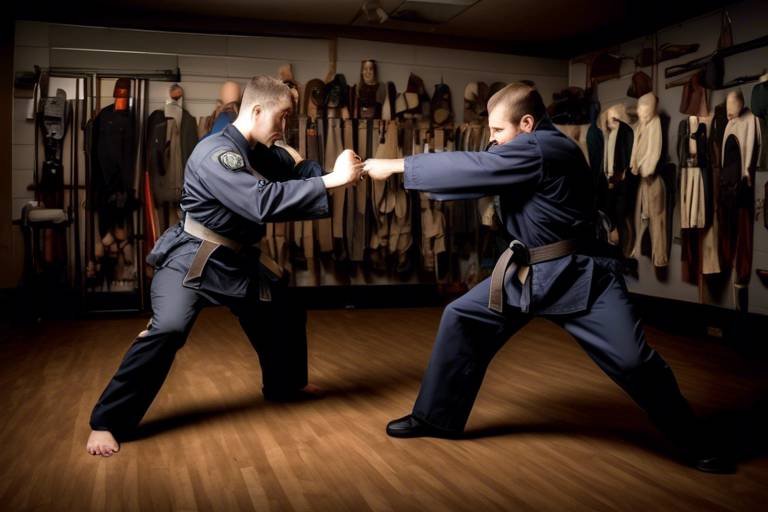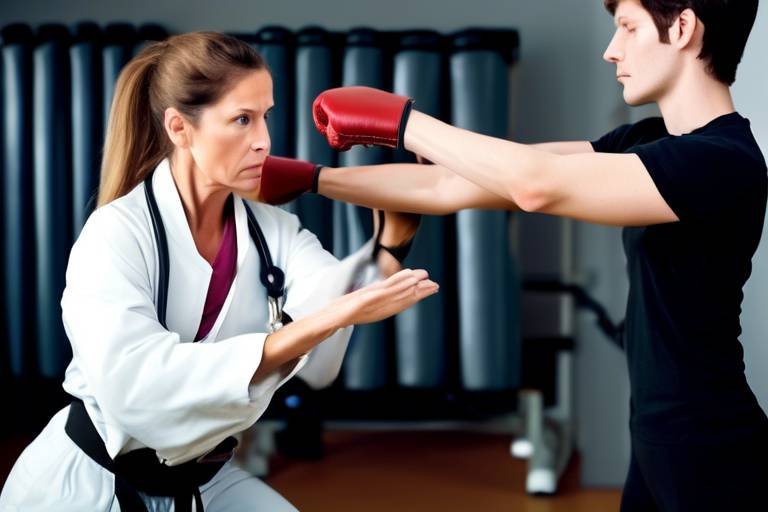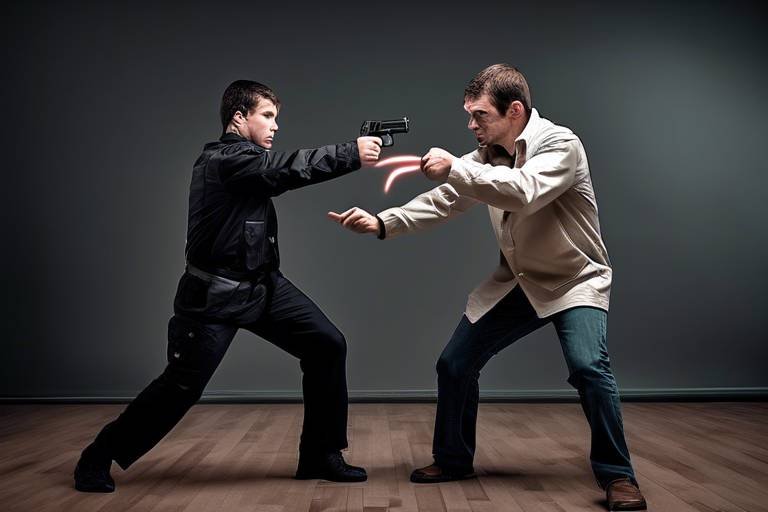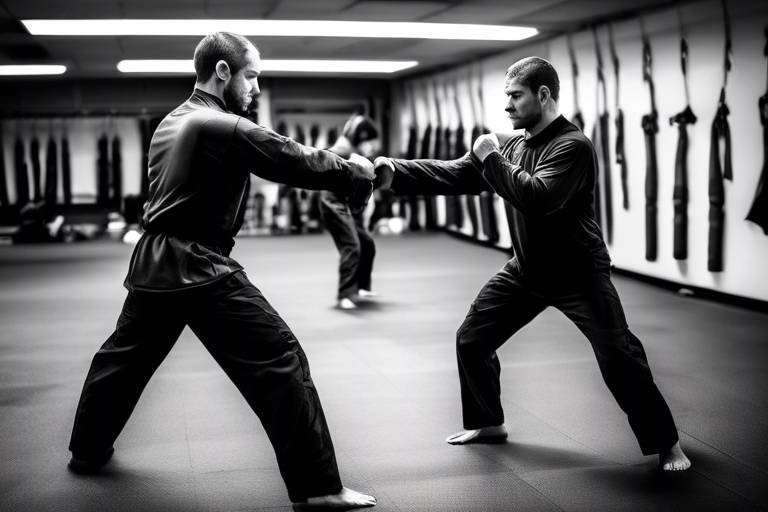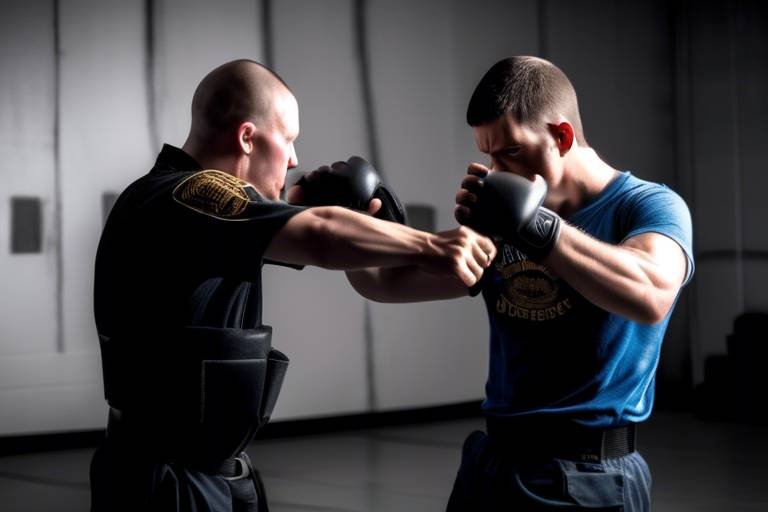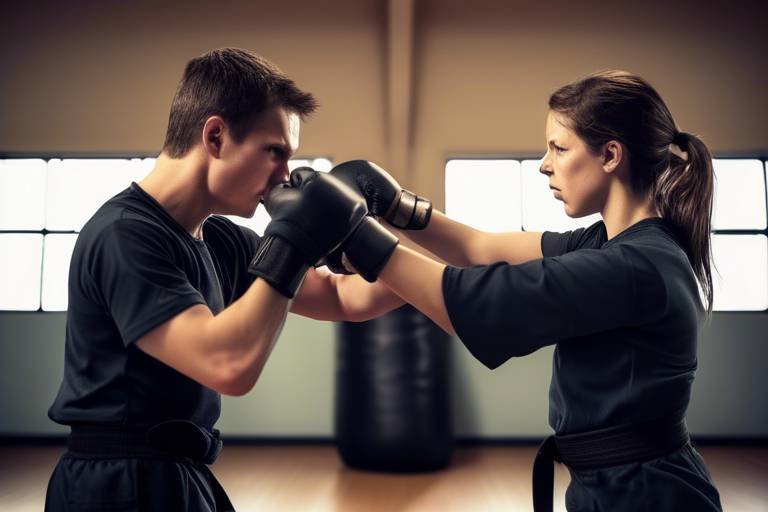Tailoring Self-Defense Techniques for Specific Environments
In today's unpredictable world, the ability to protect oneself is more important than ever. Self-defense is not a one-size-fits-all solution; it requires a tailored approach that considers the environment in which a person finds themselves. Whether you're navigating the bustling streets of a city, enjoying the tranquility of nature, or simply relaxing at home, understanding how to adapt your self-defense strategies can be the difference between safety and danger. This article delves into how to effectively customize self-defense techniques to suit various environments, ensuring that individuals are better equipped to face potential threats.
Imagine walking through a crowded urban market, where the vibrant energy of the city surrounds you. The noise of chatter and the hustle of people can be both exhilarating and overwhelming. In such an environment, self-defense techniques must be practical and quick. You need to be aware of your surroundings, identify potential escape routes, and recognize how to use the crowd to your advantage. For instance, if you find yourself in a threatening situation, creating distance between you and the aggressor is crucial. This can involve weaving through the crowd or using nearby structures for cover.
Conversely, picture yourself in a serene rural setting, where the silence is only broken by the rustling of leaves and the distant call of wildlife. While this may seem peaceful, rural areas present unique challenges, such as isolation and encounters with wild animals. Here, self-defense strategies shift dramatically. Instead of focusing solely on human threats, it becomes essential to understand how to react to wildlife. Knowing which animals pose a danger and how to respond can significantly enhance your safety. For example, if you encounter a bear, making yourself appear larger and backing away slowly can be more effective than attempting to fight back.
Furthermore, the concept of home as a sanctuary is deeply ingrained in our psyche. However, even in our own spaces, it’s vital to have a self-defense plan. This involves not just physical techniques but also mental preparedness. Knowing how to secure your home, recognizing vulnerabilities, and having a strategy for emergencies can empower you to feel safe and in control. For instance, installing effective locks, using motion sensor lights, and having a designated safe room can all contribute to a robust home defense strategy.
As we explore self-defense in recreational areas like parks and beaches, the importance of awareness becomes even more pronounced. These spaces, while enjoyable, can also harbor potential dangers. Staying vigilant, observing your surroundings, and recognizing when something feels off are essential skills. It’s like being a hawk, constantly scanning the horizon for signs of trouble. By honing your awareness, you can better prepare yourself to react promptly if a threat arises.
Lastly, having an emergency response plan is akin to having a map in unfamiliar territory. It provides direction and clarity when chaos ensues. Formulating a quick action plan tailored to different environments ensures that you are not only prepared but also confident in your ability to respond. This plan could include identifying safe locations, knowing whom to contact in emergencies, and practicing scenarios with friends or family. Just as a soldier trains for battle, being prepared can make all the difference when seconds count.
- What are the best self-defense techniques for urban environments? Urban self-defense techniques should focus on situational awareness, quick escapes, and using the environment to your advantage.
- How can I prepare for wildlife encounters in rural areas? Understanding animal behavior, recognizing dangerous wildlife, and knowing how to respond appropriately are key to staying safe.
- What should I include in my home defense plan? Consider securing entry points, having a safe room, and developing a communication strategy with family members.
- How do I stay aware in crowded public spaces? Regularly scan your surroundings, trust your instincts, and practice mindfulness to enhance your awareness.
- What is an emergency response plan? An emergency response plan outlines steps to take in various situations, including identifying safe locations and emergency contacts.

Urban Self-Defense Strategies
In the hustle and bustle of urban life, self-defense becomes a crucial skill for anyone navigating crowded streets, busy public transport, or even quiet alleyways. The city can be a thrilling place, but it also presents unique challenges that require tailored strategies for effective self-protection. Imagine walking down a bustling street, surrounded by a sea of faces, and suddenly feeling a sense of unease. How do you respond? The key is to remain aware and prepared, adapting your self-defense techniques to fit the urban environment.
First and foremost, awareness is your best friend in the city. Always keep your head up and your eyes scanning your surroundings. Are you in a crowded area? Look for exits and potential escape routes. If you feel threatened, don’t hesitate to move toward a busier location where help is more readily available. Remember, the city is full of people who can assist you, but only if you’re alert enough to recognize them.
Another important aspect of urban self-defense is understanding the potential for weapons. In a city, everyday objects can become tools for self-defense or, conversely, weapons in the hands of a would-be attacker. For instance, a pen can be used to jab at an assailant, while a backpack can serve as a shield. Consider the items you carry with you daily. They can be your allies in a dangerous situation. Always think creatively about how to use your environment to your advantage.
Quick escapes are essential in urban settings. If you find yourself in a precarious situation, knowing how to create distance between you and a threat can be a game changer. Consider practicing techniques that allow for swift movement, such as running or rolling out of harm's way. The more you practice these techniques, the more instinctive they will become when the pressure is on.
Urban environments also require a focus on de-escalation. Sometimes, the best form of self-defense is to avoid confrontation altogether. If you sense a situation escalating, try to calmly walk away or engage in conversation to diffuse tension. This doesn’t mean you should ignore your instincts; if you feel genuinely threatened, trust your gut and prioritize your safety above all else.
Let’s also talk about the importance of self-defense classes. Many urban areas offer classes that teach practical techniques tailored to city living. These classes often cover everything from personal safety tips to physical defense moves. Participating in such a class not only equips you with valuable skills but also boosts your confidence. Plus, it’s a great way to meet like-minded individuals who share your interest in safety and preparedness.
In summary, urban self-defense strategies hinge on awareness, creativity, quick escapes, and effective communication. By honing these skills, you can navigate the city with confidence and a sense of security. Remember, being prepared is not just about knowing how to fight; it’s about being smart, staying alert, and knowing when to engage or disengage.
- What should I do if I feel threatened in a crowded area? Trust your instincts and move towards a busier location. Seek help from bystanders if necessary.
- Can everyday items be used for self-defense? Yes! Objects like keys, pens, or even your backpack can be used creatively for self-defense.
- Are self-defense classes worth it? Absolutely! They provide practical skills and boost your confidence in handling potential threats.

Rural Self-Defense Techniques
When it comes to self-defense, rural settings pose a unique set of challenges that differ significantly from urban environments. In the vast openness of the countryside, you might find yourself isolated, far from the quick assistance of law enforcement or emergency services. This isolation can be both a blessing and a curse. While you enjoy the tranquility of nature, the potential for danger—be it from human threats or wildlife—requires you to be especially vigilant and prepared. So, how do you adapt your self-defense techniques to these less populated areas? Let’s explore some effective strategies tailored for rural living.
First and foremost, understanding your surroundings is crucial. In rural areas, you may encounter various threats, including wildlife and the occasional trespasser. Familiarizing yourself with the landscape can help you identify safe zones and potential escape routes. For example, knowing which paths lead back to your home or to a neighbor's house can be invaluable in a crisis. Additionally, you should always be aware of your local wildlife. Certain animals, like bears or snakes, can pose serious threats if approached carelessly. Learning the behaviors of these creatures can help you avoid dangerous encounters.
One effective method for defending yourself in rural areas is to utilize natural resources. Your environment can serve as an ally in self-defense. For instance, if you find yourself in a threatening situation, consider using items such as:
- Sticks or branches: These can be used to create a barrier or as a makeshift weapon.
- Rocks: A well-aimed rock can deter an approaching threat.
- Water: If you’re near a body of water, it can be used to create distance between you and a potential attacker.
By being resourceful and thinking on your feet, you can turn your surroundings into tools for protection.
When venturing into rural areas, it's not just human threats that you need to be concerned about; wildlife encounters can also pose significant risks. Understanding how to react to these situations can mean the difference between safety and danger. For example, if you encounter a bear, experts recommend standing your ground and making yourself appear larger, rather than running away, which may trigger a chase response. Similarly, if you come across a snake, it's crucial to remain calm and slowly back away, as sudden movements can provoke an attack.
Being able to identify potentially dangerous animals is a vital skill for anyone living or spending time in rural areas. Here are a few tips to help you recognize and understand animal behavior:
- Learn about local species: Familiarize yourself with the wildlife in your area, including their habitats and behaviors.
- Watch for warning signs: Many animals will give you cues before they feel threatened, such as growling or hissing.
- Understand their territory: Knowing where certain animals are likely to be can help you avoid encounters altogether.
By being proactive about understanding the wildlife around you, you can significantly reduce the risk of dangerous encounters.
In addition to recognizing wildlife, knowing how to use your environment to your advantage is essential. For instance, if you find yourself in a vulnerable position, look for natural barriers like bushes or trees that can provide cover or concealment. Additionally, using the terrain to your advantage can help you escape a dangerous situation. Hills, ditches, and other natural features can impede an attacker’s progress while giving you the upper hand.
In conclusion, adapting your self-defense techniques for rural settings is not just about being physically prepared; it’s also about being mentally aware and resourceful. By understanding your environment, recognizing potential threats, and utilizing available resources, you can significantly enhance your safety in rural areas.
| Question | Answer |
|---|---|
| What should I do if I encounter a bear? | Stand your ground, make yourself appear larger, and back away slowly without turning your back. |
| How can I prepare for wildlife encounters? | Learn about local wildlife, carry bear spray when hiking, and make noise to avoid surprising animals. |
| What are some natural resources I can use for self-defense? | Sticks, rocks, and even water can be utilized effectively in a threatening situation. |

Defending Against Animal Attacks
When you find yourself in a rural setting, the beauty of nature can sometimes come with unexpected challenges, particularly when it comes to wildlife. Understanding how to defend against animal attacks is not just about brute strength; it’s about being smart, aware, and prepared. Imagine walking through a serene forest, only to encounter a bear or a snake. How would you react? The key lies in knowing how to assess the situation and respond appropriately.
First and foremost, prevention is your best defense. Being aware of your surroundings and understanding animal behavior can significantly reduce the chances of an encounter. For instance, many animals are more active during dawn and dusk. If you’re hiking during these times, make noise to alert wildlife of your presence. This can be as simple as talking loudly or clapping your hands. Animals generally prefer to avoid humans, so making your presence known can help keep them at bay.
In the unfortunate event that you do find yourself facing an aggressive animal, it’s crucial to remain calm. Panic can lead to poor decisions. Depending on the animal, your response may vary:
- Bears: If you encounter a bear, do not run. Instead, back away slowly while speaking in a calm voice. If the bear charges, stand your ground. Most charges are bluffs.
- Snakes: If you see a snake, give it space. Most snakes will not attack unless provoked. If bitten, seek medical help immediately.
- Cougars: Make yourself look bigger by raising your arms and speaking firmly. Do not turn your back or run.
It’s also beneficial to carry some basic self-defense tools when exploring rural areas. Items like bear spray or a whistle can be effective deterrents. Bear spray is particularly useful as it can incapacitate an aggressive bear without causing permanent harm. Always remember to check local regulations regarding wildlife and self-defense tools, as laws can vary.
Another aspect to consider is understanding the environment. Familiarize yourself with the types of wildlife in the area you’re visiting. For example, if you’re in bear country, knowing how to identify bear tracks and scat can help you gauge their presence and avoid areas where they might be active. This knowledge can empower you to make informed decisions while enjoying the great outdoors.
In summary, defending against animal attacks requires a combination of awareness, preparation, and knowledge. By understanding wildlife behavior, carrying appropriate tools, and knowing how to react in various situations, you can significantly enhance your safety in rural environments. Remember, nature is a beautiful place, and with the right precautions, you can enjoy it while minimizing risks.
Q1: What should I do if I encounter a bear?
A1: Stay calm, back away slowly, and avoid direct eye contact. Do not run.
Q2: How can I prevent snake bites?
A2: Wear sturdy boots and long pants when hiking. Watch where you step and avoid tall grass.
Q3: Is bear spray effective against other animals?
A3: Yes, bear spray can deter other aggressive wildlife, but it’s specifically designed for bears.
Q4: What should I do if I’m bitten by a snake?
A4: Seek medical attention immediately. Keep the affected area still and below heart level.

Recognizing Dangerous Wildlife
When venturing into rural areas, it's essential to be aware of your surroundings, especially when it comes to wildlife. Understanding how to recognize dangerous animals can significantly reduce the risk of an encounter that could lead to harm. Many people may not realize that just because an animal looks cute or harmless, it doesn't mean it won't defend itself if threatened. For instance, animals like raccoons or foxes might seem friendly, but they can be unpredictable, especially if they feel cornered or if they are protecting their young.
One of the most effective ways to recognize potentially dangerous wildlife is to familiarize yourself with the types of animals that inhabit the area you are visiting. Here are a few key characteristics to look out for:
- Size and Behavior: Larger animals like bears, moose, or wild boars can be very dangerous. Their size alone is a warning sign, but also pay attention to their behavior. If an animal is acting aggressively or is not afraid of human presence, it's a good indication that you should keep your distance.
- Tracks and Scat: Learning to identify animal tracks and droppings can provide valuable insight into what wildlife is in the area. For example, bear tracks are distinct and larger than those of a deer. Recognizing these signs can help you gauge what animals might be nearby.
- Sound: Many animals have unique sounds that can alert you to their presence. A growl or a loud snort can indicate a nearby predator, while the rustling of leaves could suggest smaller animals.
Additionally, understanding the habitat preferences of dangerous wildlife can further aid in avoidance. For example, bears are often found near water sources or berry patches, while snakes tend to inhabit rocky or brushy areas. By being aware of these habitats, you can plan your activities to minimize encounters.
It's also important to remember that some animals are more active during certain times of the day. For instance, deer are often more active during dawn and dusk, which increases the likelihood of encountering them on rural roads. Being mindful of these patterns can help you stay safe.
In summary, recognizing dangerous wildlife involves a combination of knowledge, observation, and vigilance. By understanding the signs of danger and the behaviors of local animals, you can enjoy your time in nature while minimizing risks. Always remember to respect wildlife and maintain a safe distance, as this not only protects you but also the animals themselves.
Q1: What should I do if I encounter a bear?
A: If you encounter a bear, remain calm and avoid sudden movements. Speak to the bear in a calm voice, and back away slowly. Do not run, as this may trigger a chase response.
Q2: How can I tell if a snake is venomous?
A: Venomous snakes often have distinct markings or colors, such as the triangular head of a rattlesnake. However, it’s best to keep a safe distance and avoid any snake you encounter.
Q3: Are raccoons dangerous?
A: Raccoons can be dangerous, especially if they are rabid. Avoid approaching them, and do not try to feed them.
Q4: What should I carry for self-defense against wildlife?
A: Bear spray is a popular and effective option for deterring wildlife. Additionally, knowing how to use a whistle or other noise-making devices can help scare off animals.

Using Natural Resources for Defense
When you find yourself in a rural setting, the environment can be both a friend and a foe. Understanding how to leverage natural resources for self-defense can be a game-changer. Imagine being in the middle of a serene forest, surrounded by towering trees and the sounds of nature, when suddenly you feel threatened. Instead of panicking, you can turn to your surroundings for help. The key is to recognize what’s available and how to use it effectively.
First and foremost, awareness of your environment is crucial. Take a moment to observe your surroundings. Are there any sturdy branches nearby? Is there a rock you could use as a makeshift weapon? Even something as simple as dirt or sand can be advantageous. For instance, if you find yourself cornered, throwing sand in an attacker’s eyes can give you the precious seconds you need to escape. The element of surprise is a powerful tool!
Moreover, consider the plants around you. Some plants can be used for defense or distraction. For example, if you encounter a wild animal, certain plants can be used to create a barrier or to mask your scent. Additionally, learning about local flora can help you identify plants that might be used to your advantage. For instance, if you’re in an area with thorny bushes, you could use them to deter an approaching threat.
Another aspect to consider is the use of sound. In rural areas, making noise can scare off potential threats, whether they are animals or people with ill intentions. Utilizing your voice to yell or even using a whistle can alert others nearby and deter attackers. Remember, the goal is to create a situation that favors your escape.
Here’s a quick overview of how to use natural resources effectively:
| Resource | Usage |
|---|---|
| Branches | Can be used as a weapon or to create a barrier. |
| Rocks | Effective as a throwing object or for defense. |
| Plants | Can mask your scent or create distractions. |
| Sound | Yelling or using a whistle can attract help or scare off threats. |
Lastly, remember that practice makes perfect. Familiarize yourself with your environment and practice using these resources. The more comfortable you are, the more instinctual your reactions will be in a threatening situation. By incorporating these strategies into your routine, you can transform the natural landscape into your personal defense toolkit.
Q: What should I do if I feel threatened in a rural area?
A: Stay calm, assess your surroundings, and look for natural resources that can aid in your defense. Use your voice to alert others and create distance from the threat.
Q: Can I use plants for self-defense?
A: Yes, certain plants can be used to create barriers or distractions. Familiarize yourself with local flora to understand their potential uses.
Q: How can I practice using natural resources for defense?
A: Spend time in your local environment, exploring and identifying available resources. Practice scenarios where you might need to use them for defense.

Home Defense Techniques
Home is often considered our sanctuary, a place where we feel the most secure. However, it’s crucial to recognize that even in our safe havens, threats can arise. Developing effective self-defense techniques for your home can empower you and your loved ones to respond swiftly and effectively in case of an emergency. So, how do we transform our homes into fortresses without turning them into prisons?
First and foremost, the key to home defense is awareness. Being aware of your surroundings and the potential vulnerabilities in your home can make all the difference. Start by assessing your home’s entry points. Are your doors solid? Do your windows have secure locks? Consider investing in high-quality deadbolts and window locks to fortify these vulnerable areas. Additionally, installing a security system can act as a deterrent for potential intruders. Many modern systems offer features like video surveillance, motion detectors, and smartphone alerts, providing peace of mind whether you’re home or away.
Another effective home defense technique is to establish a safety plan with your family. This plan should include designated safe spots within your home where everyone can gather in case of an emergency. For instance, a fortified room with a lock can serve as a secure location until help arrives. Discussing this plan with your family can ensure that everyone knows what to do when the unexpected occurs. It’s like having a fire drill, but for home invasions!
Moreover, consider enhancing your home’s exterior. Simple measures such as installing motion-activated lights can illuminate dark areas around your property, making it less inviting for intruders. Keeping bushes and trees trimmed can eliminate hiding spots, while a well-lit yard can deter potential threats. Think of your home as a beacon of safety—the brighter it shines, the less likely it is to attract unwelcome visitors.
In addition to physical security measures, having a personal defense tool can be beneficial. Items such as pepper spray, personal alarms, or even self-defense keychains can provide an extra layer of protection. However, it’s essential to familiarize yourself with the laws regarding self-defense tools in your area to ensure you’re compliant and can use them safely and effectively.
Lastly, don’t overlook the importance of community awareness. Getting to know your neighbors can create a network of support and vigilance. Consider starting or joining a neighborhood watch program. This collaboration can foster a sense of security and ensure that everyone is looking out for one another. After all, there’s strength in numbers!
In summary, home defense techniques encompass a blend of awareness, preparedness, and community engagement. By taking proactive steps to secure your home and creating a comprehensive safety plan, you can significantly enhance your ability to protect yourself and your loved ones. Remember, it’s not just about having the tools; it’s about knowing how and when to use them effectively.
1. What are the most effective home security measures?
The most effective measures include installing solid doors with high-quality locks, using a security system with cameras, and ensuring your property is well-lit.
2. How can I create an emergency safety plan for my family?
Discuss potential scenarios with your family, designate safe spots in your home, and practice your plan regularly to ensure everyone knows what to do in case of an emergency.
3. Are personal defense tools legal to carry in my area?
Laws regarding personal defense tools vary by location. Always check local regulations to ensure compliance and safety when carrying any self-defense items.
4. How can I get to know my neighbors better?
Consider hosting a neighborhood gathering or joining local community groups. Building relationships with your neighbors can foster a sense of community and security.

Self-Defense in Recreational Areas
When we think about recreational areas, images of relaxing parks, sunny beaches, and fun-filled outdoor activities come to mind. However, amidst the laughter and joy, it’s crucial to remember that these places can also harbor unexpected dangers. Being mindful of your surroundings is essential. Imagine you’re enjoying a serene day at the park, but suddenly, a stranger approaches you. What do you do? This is where self-defense tactics come into play.
In recreational settings, the dynamics of self-defense change. Unlike the confines of an urban environment where you might have quick access to help, in parks or beaches, you may find yourself isolated. Hence, it’s vital to adopt strategies that are tailored to these open spaces. One of the key aspects of self-defense in these areas is maintaining awareness. This means not just looking out for potential threats but also being conscious of your environment. Are there other people around? Is there a safe route to exit if needed? By asking these questions, you can significantly enhance your safety.
Moreover, staying aware doesn’t just involve looking around; it also includes understanding the behavior of those around you. For instance, if you notice someone acting suspiciously, it’s wise to keep your distance. Trust your instincts! If something feels off, it probably is. In recreational areas, you can also leverage your surroundings to your advantage. For example, if you're on a beach, the lifeguard station or a group of people can serve as safe havens if you feel threatened.
Another important element of self-defense in recreational areas is having a plan. Just as you wouldn’t embark on a hike without knowing the trail, you shouldn’t venture into public spaces without a strategy. Consider discussing self-defense tactics with friends or family before heading out. This could include setting up a meeting point in case someone gets separated or agreeing on signals to alert each other of potential danger. Having a plan not only boosts your confidence but also enhances your overall safety.
To further emphasize the importance of preparedness, let’s look at some practical self-defense tips for recreational areas:
- Stay in groups: There’s safety in numbers. Whenever possible, enjoy recreational activities with friends or family.
- Know your exits: Familiarize yourself with the layout of the area. Identify where the nearest exits are located.
- Keep your phone handy: Ensure your phone is charged and easily accessible for emergencies.
- Trust your gut: If something doesn’t feel right, don’t hesitate to leave the area or seek help.
In conclusion, self-defense in recreational areas requires a mix of awareness, preparation, and the ability to adapt to your surroundings. By staying vigilant and having a plan, you can enjoy your time outdoors while ensuring your safety. Remember, it’s not about living in fear; it’s about being prepared and confident in your ability to protect yourself when necessary.
Q: What should I do if I feel threatened in a public space?
A: Trust your instincts and try to remove yourself from the situation. Seek help from nearby individuals or authorities if necessary.
Q: How can I improve my self-defense skills?
A: Consider taking self-defense classes that focus on practical techniques suited for various environments.
Q: Is it safe to use my phone in recreational areas?
A: While it’s okay to use your phone, remain aware of your surroundings and avoid distractions that could make you vulnerable.

Staying Aware in Public Spaces
When it comes to self-defense, one of the most powerful tools you can possess is **awareness**. Imagine walking through a bustling city street or a crowded park, surrounded by the sounds of laughter, traffic, and music. It's easy to get lost in the moment, but keeping your head up and your senses sharp can mean the difference between safety and danger. Awareness is not just about seeing what’s in front of you; it’s about understanding your environment, anticipating potential threats, and reacting accordingly.
Being aware in public spaces involves a few essential practices. First, always be conscious of your surroundings. This means scanning the area for anything or anyone that seems out of place. Are there individuals loitering without purpose? Is someone following you? By **actively observing** your environment, you can identify potential risks before they escalate. For instance, if you notice a group of people behaving aggressively, you might choose to change your route or find a nearby store to enter until the situation calms down.
Another critical aspect of awareness is **understanding body language**. People communicate a lot through their posture, facial expressions, and movements. If someone approaches you with a tense posture or an intense glare, it could signal that they are up to no good. Trust your instincts—if something feels off, it probably is. Moreover, don’t hesitate to make eye contact with others around you. This simple act can deter potential aggressors, as it shows that you are alert and not an easy target.
Additionally, keeping your personal belongings secure and close to your body can prevent theft and distractions. When you’re busy fumbling around in your bag or on your phone, you become an easy target for pickpockets or opportunistic thieves. Instead, consider using a crossbody bag or a fanny pack that you can easily access while keeping an eye on your surroundings. Remember, your safety is more important than checking your social media feed in a public space.
Here are a few tips to enhance your awareness in public spaces:
- Stay off your phone while walking. It’s easy to become oblivious to your surroundings when you’re engrossed in a screen.
- Walk with purpose. Keep a confident posture and a steady pace; this can discourage potential threats.
- Trust your gut feelings. If something doesn’t feel right, it’s better to be safe than sorry.
- Familiarize yourself with emergency exits and safe spots in public places.
Ultimately, staying aware in public spaces is about being proactive rather than reactive. By developing your situational awareness, you can create a safer experience for yourself and those around you. Remember, awareness is like a shield; the more you practice it, the stronger it becomes. So, the next time you step into a crowded area, take a deep breath, scan your surroundings, and carry that sense of vigilance with you. It’s your best defense against unexpected situations.
Q: What should I do if I feel threatened in a public space?
A: Trust your instincts. If you feel threatened, try to remove yourself from the situation as quickly as possible. Seek help from nearby individuals or authorities if necessary.
Q: How can I practice awareness in my daily routine?
A: You can practice awareness by being mindful of your surroundings. Start by observing the people and environment around you during your daily commutes or outings. Gradually, this will become a habit.
Q: Are there any apps that can help with personal safety?
A: Yes, there are several personal safety apps available that can alert friends or authorities in case of an emergency. Look for features like location sharing, emergency contacts, and quick access to help.
Q: What is the best way to handle a confrontation?
A: If confronted, try to remain calm. Assess the situation, use verbal de-escalation tactics if appropriate, and look for an escape route. If necessary, don’t hesitate to defend yourself.

Emergency Response Plans
When it comes to self-defense, having a solid emergency response plan can be the difference between safety and danger. Imagine you're out for a walk in the park, enjoying the fresh air, when suddenly, an unexpected situation arises. How would you react? This is where a well-thought-out plan comes into play. An emergency response plan not only prepares you for potential threats but also instills a sense of confidence and control in uncertain situations.
First and foremost, it's essential to assess your environment. Different locations pose different risks. For instance, urban areas may have a greater likelihood of encountering aggressive individuals, while rural settings might expose you to wildlife. By understanding the unique challenges of your surroundings, you can tailor your response plan accordingly. Consider creating a mental map of your area, noting potential escape routes and safe havens.
Next, communication is key. In any emergency, being able to reach out for help can be crucial. Make sure your phone is charged and easily accessible. Additionally, inform a friend or family member about your whereabouts, especially if you're venturing into less populated areas. This simple step can significantly enhance your safety.
Another vital aspect of your emergency response plan is to practice situational awareness. This means being aware of your surroundings and recognizing potential threats before they escalate. For example, if you notice someone following you, trust your instincts and take action. Whether it's changing your route or seeking help, being proactive can prevent a potentially dangerous situation.
It's also beneficial to have a list of local emergency contacts readily available. You might think, "I'll remember the numbers," but in a moment of panic, it can be challenging to recall them. Here’s a simple table to help you organize this information:
| Emergency Contacts | Phone Number |
|---|---|
| Local Police Department | (Insert Number) |
| Nearest Hospital | (Insert Number) |
| Trusted Friend/Family | (Insert Number) |
Moreover, consider having a basic self-defense tool on hand, such as pepper spray or a personal alarm. These items can serve as deterrents and provide you with a sense of security. However, remember that tools are only effective if you know how to use them properly. Therefore, take the time to practice with whatever self-defense tools you choose to carry.
Finally, don't overlook the importance of mental preparation. Visualize different scenarios and how you would respond. This mental rehearsal can help you react more effectively when faced with real-life situations. Remember, staying calm and collected is crucial in emergencies, and having a plan can help you achieve that.
In conclusion, an emergency response plan is not just a safety net; it's a proactive approach to self-defense. By assessing your environment, maintaining communication, practicing situational awareness, organizing emergency contacts, carrying self-defense tools, and preparing mentally, you can significantly enhance your safety in any situation. So, take a moment today to create or refine your emergency response plan. Your safety is worth it!
- What should I include in my emergency response plan? Focus on local emergency contacts, escape routes, and communication strategies.
- How can I stay aware of my surroundings? Practice mindfulness and regularly scan your environment for unusual behavior or potential threats.
- Is it necessary to carry self-defense tools? While not mandatory, having a self-defense tool can provide an added layer of security.
- How do I mentally prepare for emergencies? Visualize potential scenarios and practice your responses to build confidence.
Frequently Asked Questions
- What are some effective self-defense techniques for urban environments?
In urban settings, it's crucial to stay aware of your surroundings. Techniques like quick escapes, using nearby objects as shields, and employing verbal de-escalation can be very effective. Remember, the goal is to avoid confrontation whenever possible!
- How can I defend myself in rural areas?
In rural settings, focus on situational awareness and understanding the environment. Techniques may include using natural resources for defense, like sticks or rocks, and knowing how to react to wildlife encounters. Always be prepared for unexpected situations!
- What should I do if I encounter a wild animal?
If you come across a wild animal, stay calm and avoid sudden movements. Make yourself look larger by raising your arms, and speak in a firm voice. Back away slowly without turning your back on the animal. Understanding animal behavior can greatly enhance your safety!
- How can I improve my home defense?
Enhancing home defense involves creating a security plan, securing entry points, and having self-defense tools accessible. Consider investing in good lighting, alarms, and even practicing emergency drills with your family to ensure everyone knows what to do in case of an intruder.
- What should I be aware of in public spaces?
Awareness is key in crowded areas. Always keep an eye on your surroundings and trust your instincts. Avoid distractions like your phone when walking, and be alert to potential threats, such as people acting suspiciously or following you.
- How can I create an emergency response plan?
To formulate an emergency response plan, identify potential risks specific to your environment, whether urban or rural. Discuss and practice your plan with family or friends, ensuring everyone knows their role. Regularly review and update the plan as necessary!

